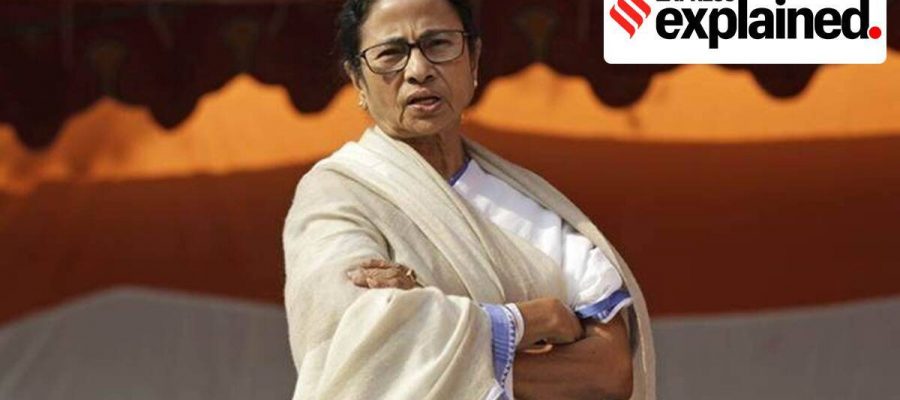Currently, six states — Bihar, Uttar Pradesh, Maharashtra, Andhra Pradesh, Telangana and Karnataka — have a Legislative Council.
Earlier this week, the Trinamool Congress government in West Bengal approved the setting up of a Legislative Council in the state. It was a promise made by the party in its election manifesto. West Bengal’s Legislative Council was abolished 50 years ago by a coalition government of Left parties.
Currently, six states — Bihar, Uttar Pradesh, Maharashtra, Andhra Pradesh, Telangana and Karnataka — have a Legislative Council. The setting up of a second chamber is not exclusively in the hands of the state government. The central government also has to pilot a Bill in Parliament. This issue could, therefore, lead to another potential flash point between the state and the Centre.
How Councils came to be
Legislatures with two Houses (bicameral) have a long history in India. The Montagu-Chelmsford reforms led to the formation of the Council of State at the national level in 1919. Then the Government of India Act of 1935 set up bicameral legislatures in Indian provinces. It was under this law that a Legislative Council first started functioning in Bengal in 1937.
During the framing of the Constitution, there was disagreement in the Constituent Assembly on having a second chamber in states. The arguments in support of Rajya Sabha — that a second chamber acts as a check on hasty legislation and brings diverse voices into legislatures — did not cut ice with many Constituent Assembly members when it came to the states.
Newsletter | Click to get the day’s best explainers in your inbox
Prof K T Shah, from Bihar, said a second chamber in states “involve considerable outlay from the public exchequer on account of the salaries and allowances of Members and incidental charges. They only aid party bosses to distribute more patronage, and only help in obstructing or delaying the necessary legislation which the people have given their votes for”.
The framers of the Constitution provided that in the beginning, the states of Bihar, Bombay, Madras, Punjab, the United Provinces and West Bengal would have a Legislative Council. Then they gave states the option of abolishing an existing second chamber or setting up a new one by passing a resolution in their Legislative Assembly. The Constitution also gave the Legislative Assembly the power to overrule the Council if there was a disagreement between them on a law. The Constitution also capped the membership of the council to one-third of the popularly elected Legislative Assembly.
West Bengal’s Council
The West Bengal Legislative Council remained in existence till 1969. But it was events in the second chamber two years prior that led to its abolition. The fourth general elections held in 1967 led to the Congress losing power in multiple states. In West Bengal, the United Front, a coalition of 14 parties, formed the government with Congress in the Opposition. Chief Minister Ajoy Kumar Mukherjee led the government with Jyoti Basu as the Deputy CM. But the coalition did not last long, and Governor Dharam Vira dismissed the government after eight months.
P C Ghosh, an independent MLA who had earlier been Chief Minister, once again assumed the post with the support of the Congress. Different scenes played out in the two Houses of the West Bengal legislature. In the Assembly, the Speaker called the Governor’s actions unconstitutional. But the Congress-dominated council passed a resolution expressing confidence in the Ghosh-led government. This resolution sounded the death knell for the Legislative Council.
After midterm elections in 1969, the second United Front came to power. In the 32-point programme on which it had fought the elections, point number 31 was the abolition of the Legislative Council, which was one of the first things the government did when it came to power.
Article 168 of the Constitution empowers the Legislative Assembly to create or abolish a Legislative Council by passing a resolution. The resolution has to be passed by two-thirds of the Assembly members. Then a Bill to this effect has to be passed by Parliament. The West Bengal Assembly passed this resolution in March 1969, and four months later, both Houses of Parliament approved a law to this effect. Punjab followed suit, abolishing its Legislative Council later that year.
Councils in other states
However, having or not having a Legislative Council is a political issue. For example, in Tamil Nadu, creating a Council has been a contentious issue for the last three decades. The AIADMK-led government in 1986 abolished the state’s second chamber. Since then, DMK has made attempts to re-establish the Council, and AIADMK has opposed such moves. The DMK’s manifesto for the recently concluded elections again promises the setting up of a second chamber.
The Congress made a similar promise in the 2018 Madhya Pradesh elections. In Andhra Pradesh, the Legislative Council was first set up in 1958, then abolished by the TDP in 1985 and re-established by the Congress in 2007. Last year, the Legislative Council dominated by the TDP referred three Capital Bills to a Select Committee, which led to the YSRCP-controlled Legislative Assembly passing a resolution to abolish the legislative council.
However, passing a resolution in the Legislative Assembly is not enough to abolish or establish a Legislative Council. A Bill for such creation or dissolution has to be passed by Parliament. The Assam Assembly in 2010 and the Rajasthan Assembly in 2012 passed resolutions for setting up a Legislative Council in their respective states. Both Bills are pending in Rajya Sabha. And the Bill for abolishing the Andhra Pradesh Legislative Council has not yet been introduced in Parliament.
Chakshu Roy is Head of Outreach at PRS Legislative Research
Source: Read Full Article


